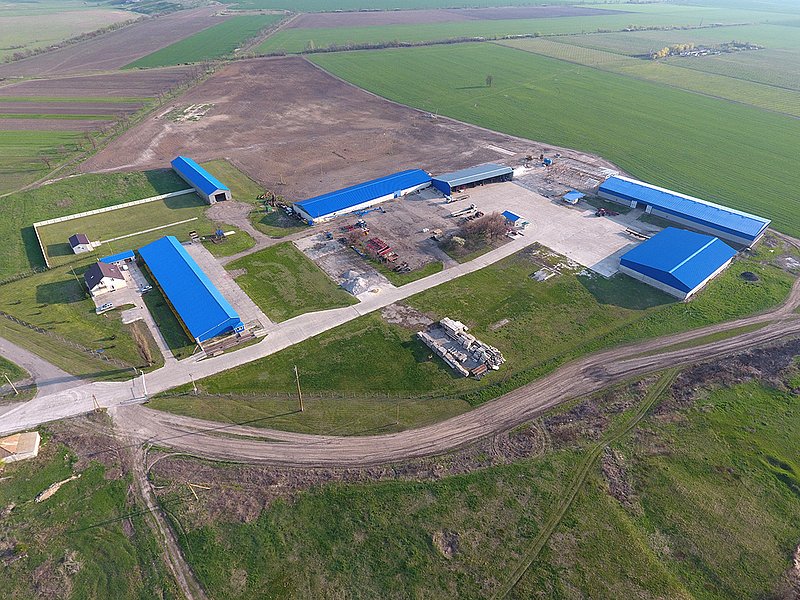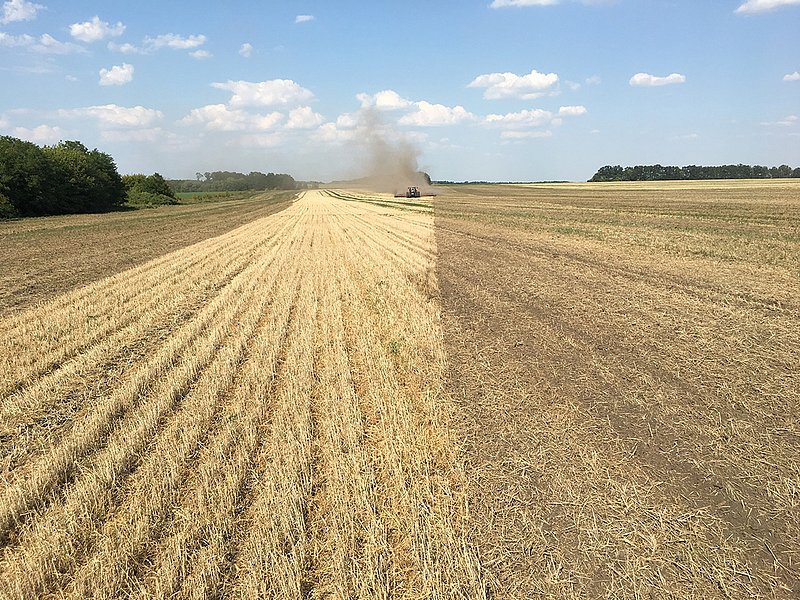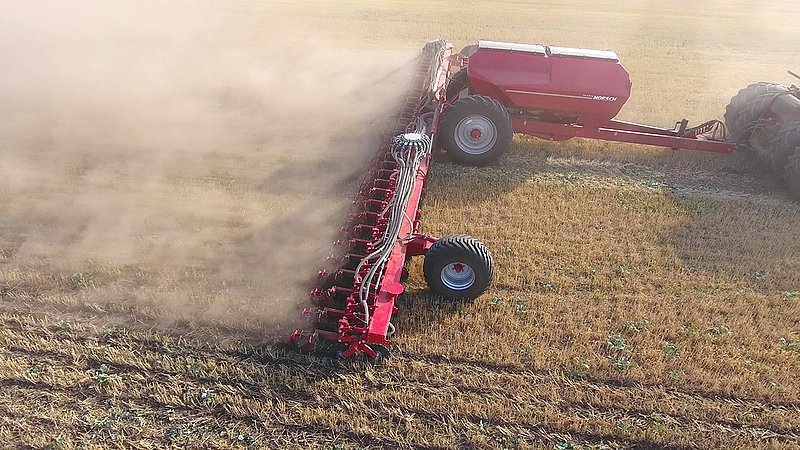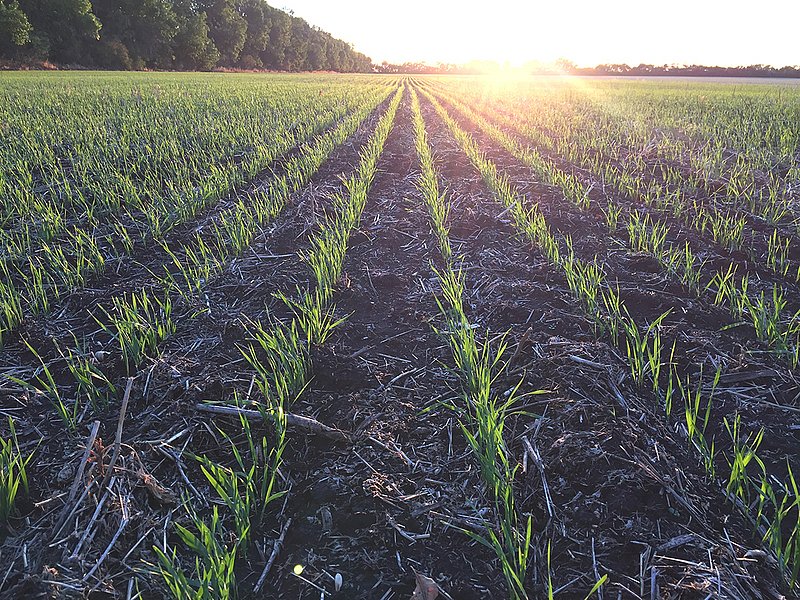Start now to look ahead
Agro KMR (UA)
In issue 14/2017 terraHORSCH presented the farm Agro KMR in the Ukraine. Jean Paul Kihm gives us another look behind the scenes.
This time we mainly wanted to learn something about the strategy of the farm with regard to population management and technology: Controlled Traffic Farming (CTF) with 12 m or with 18 m? Is a rotation with multiple crops better? Should you go for no-till farming or rather bank on other methods? There are a lot of things to consider. And they all have one objective: to optimize the farm Agro KMR.

Unlimited imagination
First and foremost, Agro KMR is the history of four men: in 2006 the four French farmers Jean Paul Kihm, Alan and Florent Renard and Jean Loup Michel founded Agro KMR near Pavlohrad in the Ukraine. The farm employs 50 people and cultivates 12,000 ha: 6,000 ha of wheat, 3,000 ha of rape and 3,000 ha of sunflowers. The four friends are open to any idea and, thus, there are a lot options: Should the arable land be increased, are there possibilities to reduce the mechanisation costs, how about CTF, should they invest in R & D, is there further potential with regard to rotation, logistics, plant strategy…? Or would it help to train the drivers better, to go for Strip-till, to make CTF more effective? The partners look into a lot of ideas and approaches. Everything is constantly put to test.
Jean Paul Kihm emphasises categorically: „Our philosophy is clear: An arable farm has no right to exist if it cannot generate sufficient income for the owners and the employees. The chosen crops have to be profitable, the costs have to be cut to a minimum. We constantly keep in mind that the farm has to respect the limits of arable and human resources to subsist. The two belong together! And to be profitable, you have to test every interesting approach.“
Optimise logistics – reduce costs
Almost all projects of Agro KMR are based on this principle. “Some years ago, we decided to test CTF. We mainly wanted to optimise spraying and the spreading of fertiliser because with the respective tools we carry out most of the passages on the fields.
We have black earth soils, i.e. 60 % silt, 30 % clay and some sand. They are prone to compaction. In the first years – before the optimisation of the tracks – we used a fertiliser spreader with a road tyre profile. We drove on the fields without fixed tracks thus causing compaction (see Quick Facts „Controlled Traffic Farming“). These tracks were still there at the time of the harvest. With CTF we were able to reduce compaction so that the plant developed more homogeneously – only by reducing the number of passes.“
Apart from the arable aspect there are various advantages:
- According to US American, Canadian and Australian surveys there is a total plus with regard to the net margin of 13 %.
- Less wear, less horsepower requirement
- Logistic advantage: even if the GPS signal is interrupted, the driver can see the tracks
- Less fuel consumption
- Lower mechanisation costs: as the structure of the soil is not damaged, the soil does not have to be cultivated intensely
Due to these first successful experiences Agro KMR decided to step-by-step convert the farm to CTF with 18 m. They already work with two 36-m-sprayers, one Avatar 18 SD (a second one will be delivered in July), one Maestro 36 SW and one Evo prototype. „The only machine missing is an 18-m Cultro – at the moment we only have a 12 m one. The same is true for the combine“, Jean Paul Kihm explains. To convert to 18 m is a real challenge, especially the organisation of the harvest. „There are only a few manufacturers who offer combines with the corresponding cutting units. Especially because of the straw distribution problems. Moreover, the discharge augers tend to brake as they are not stable enough. You have to place the auger on the wall of the auger wagon.“

A lot of people might wonder: Why convert to CTF with 18 m when CTF with 12 m is much more common. Though it requires considerable investments and the whole logistics on the field has to be reconsidered, the savings are enormous: “To change from a 12-m to an 18-m cutting unit is no problem for the combine as the motor design already is accordingly. Therefore, the operational speed is not affected. Thus, our savings on the investments per hectare are enormous.“
But CTF only is the visible part of a strategy that is completely aimed at the optimisation of the population management. Jean Paul Kihm continues: „We invested in a telemetry app which allows for identifying the location of every single machine. An example: At the moment, we are looking into a filling strategy for the seed drills. Our previous system is not particularly efficient, we lose too much time. Depending on the skills of the driver it takes between 20 and 40 minutes. In the future, we will reduce this to 10 to 15 minutes. We will be filling every two hours as usual, but save 240 minutes per day. Thus, we are able to sow 72 hectare more per day, i.e. the probability that we can sow all crops under optimum conditions is much higher – with less material.“
Quick Facts: Controlled Traffic Farming
For HORSCH agronomic topics always are the basis for the development of machines. The objective of CTF is to reduce the absolute area of fields that are affected by the passes by fixing tracks in advance. This requires an equal track width of the machines and a RTK steering system. The fixed track for every machine, the determination of the field entries and exits, filling spots and so on – all this additionally allows for a better organisation of the tasks. Compacted surfaced can be reduced from 80 % to 19 %, partly even to 12 % (depending on the width of the machine). Since 2013 AgroVation, one of the HORSCH farms in the Czech Republic has been working with CTF.
Agro KMR also deals intensely with automation: „ We expect a lot from automation, especially for the regulation of the operational speed, the processes on the headlands and with regard to the adjustment of the combine. Especially for the latter there are a lot of parameters which are strongly influenced by the human factor. For example, we found out that harvesting was much more efficient in the morning as the speed was higher. In the afternoon, when the drivers got tired, they drove more slowly.“ All this will have consequences on the tasks of the employees – but in a positive sense. “In addition, we want to improve the training of our drivers“, Jean Paul Kihm assures. „They are to be trained as good as our service technicians.“
CTF, telematics, automation … Due to their own R & D fund – it amounts to 4 % of the farm turnover - Agro KMR first invested in these technologies, tested them and finally put them into practice on the whole farm. The three topics correspond to the most important objective of the company: reduce the costs to a minimum. But what about the profitability of the individual crops and the cultivation of the soils in the long run?
Benefit from the characteristics of the site
„For ten years now we have again and again been reconsidering which rotation is the best“, Jean Paul Kihm explains. “We have tested several, especially with sorghum and peas – as we know it from France. But we also tested the traditional Ukrainian rotation with rape-wheat-sunflowers-wheat on several hectares. From an economic point of view the latter is the most profitable version. We can afford this rotation as we do not have the weed problems like in France. In the Ukraine there is neither resistant black grass nor rye grass. At the most there is ragweed, but it can be fought with a herbicide.“
These three crops perfectly match the climate and the soil conditions of the site. The very fertile black earth soils with an excellent water-holding capacity are said to be black gold. However, the average annual rainfall only amounts to 550 mm, it often is very hot in spring. In May, peak temperatures of 30° or 35° are possible. This does not allow for spectacular yields. For your orientation: with regard to wheat Agro KMR in average harvests 40 to 50 dt per hectare. Moreover, the black earth soils are very prone to wind and rain erosion.
„At first, we had a Joker 12 RT, a Terrano 12 FM, a HORSCH disc seed drill with 18 meter working width and a Maestro 36 SW. But because of the particularities of the soils we soon reached the limits of the system. We step by step turn to a shallower tillage, no-till farming and StripTill. We have sold all machines except for the Maestro 36 SW and bought a HORSCH Evo (prototype), a HORSCH Cultro (prototype) and an Avatar 18 SD.“

The idea to turn to StripTill was born when the four farmers started to focus on the cultivation of sunflowers. To avoid soil erosion and snow drifts, the stubbles previously remained on the field the whole winter. But the area that was covered with straw heated up more slowly in spring than the dark earth. Thus, the sowing dates were postponed. The advantage of StripTill is that the seed furrow is cleaned at a depth of 12 to 13 cm before the sunflowers are sown into the warmed-up soil – without destroying the stubbles.
„We decided to test the Evo prototype (see Quick Facts „Prototype testing“) because the discs are able to work in all conditions. For a StripTill machine with tines it is much more difficult to penetrate very dry soils – but these are exactly the conditions we have to deal with in autumn. It constantly releases and it is not possible to keep up a constant working depth. Moreover, the horsepower requirement for discs is lower: For a StripTill machine with tines you need a tractor with 600 hp. We only need 400 hp.“
The farm prefers two strategies to sow sunflowers, wheat and rape. For sunflowers one pass is carried out with the Evo before sowing with the Maestro to cultivate and fertiliser the bands. The rape lots are either prepared with the Evo and then sown with the Maestro or the preparation is carried out with the Cultro – a double knife roller with large working width that cultivates the soil superficially and allows for a distribution of the straw right after the harvest – then the Avatar is used for sowing. “We did not notice any decline in yield so we cannot say definitely which method is the best. As the continental climate only offers very short growth periods for the plants a spacing of 25 cm basically seems more reasonable than 50 cm. But we cannot yet prove this with definite figures.” The wheat fields after sunflowers are only cultivated with the Cultro before sowing with the Avatar.
„We want to cultivate the soil as little as possible. For if it is not turned an intensive cultivation is not necessary. Moreover, tillage increases our mechanisation costs. If possible, we distribute the straw with a simple hoeing harrow, then we sow directly. However, with sunflowers as the previous crop the straw management is crucial. In the Ukraine, the grain/straw ratio is completely different than in France, there are a good deal more residues. This is the reason why we have to let the straw dry after the harvest, crush it and distribute it evenly. Thus, we achieve a constant straw coverage that keeps the water and the nutrients in the soil. It also helps to keep rodents away. The Cultro is ideal as the soil is not cultivated too much.“

Standardisation
The long-term objective definitely is to reduce the costs once more. “With regard to the performance tractors between 380 and 400 hp are sufficient for the farm. Our objective is to standardise the whole machinery park. If one tractor fails, we can replace it quickly and do not have to worry about equipment, linkage or performance. By using the tractors and machines for all crops we save costs on new investments per hectare.
We want to standardise as many activities as possible as already describe above in the example of the seed drill filling. But this does not work for tasks that require human involvement, e.g. with regard to agronomic topics or the repair and maintenance of the machines. Due to the standardisation of routine task we release resources we can use to make sure that our employees can build up expert knowledge. And this is important: For who knows which challenges the future will bring.“
Quick Facts: Prototype testing
HORSCH Cultro TC: The name Cultro TC stands for a new HORSCH product line the development of which is in full swing. Driven by the extremely positive experiences with the knife rollers at the well-known Joker RT line the Cultro TC is equipped with two crosswise cutting knife rollers. The Cultro line will include machines from 3 m to currently 12 m working width and it will be possible to combine the trailed version with a packer or a harrow. The Cultro TC is ideal for the first, very shallow stubble cultivation in rape, sunflowers, grain maize and friable residues of cereals. It also can be used to work down respectively incorporate catch crops. The horsepower requirement is low and the machine excels due to the high hectare output, low costs and its versatility.
HORSCH Evo: The HORSCH Evo has been designed as a tillage and seedbed preparation tool. However, it does not cultivate the whole surface, but strips according to the respective row spacing of the crop. It is used to prepare the field for traditional row crops like maize, soya beans, sugarbeets or sunflowers. The Evo is equipped with single row elements to intensely cultivate and crumble a strip at a depth of approx. 10 cm with angled discs. During the cultivation pass mineral solid fertiliser can be placed in the strips. The machine is based on the seed wagon of the well-known Maestro SW line. With a capacity of 8500 litre and a working width of up to 18 m the machine is extremely efficient. The standard hydraulic weight transfer from the seed wagon to the tool bar guarantees the safe penetration of the disc units over the whole machine width. The Evo can be used when you want to use as little tillage as possible or direct drilling, but when at the same time the seed strip should be clearly defined to achieve an optimum emergence.